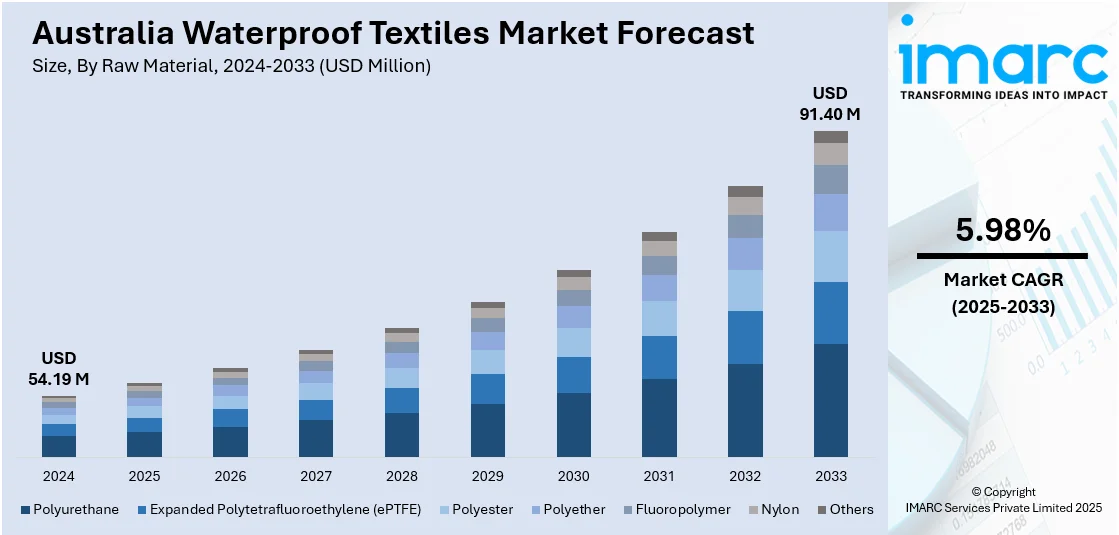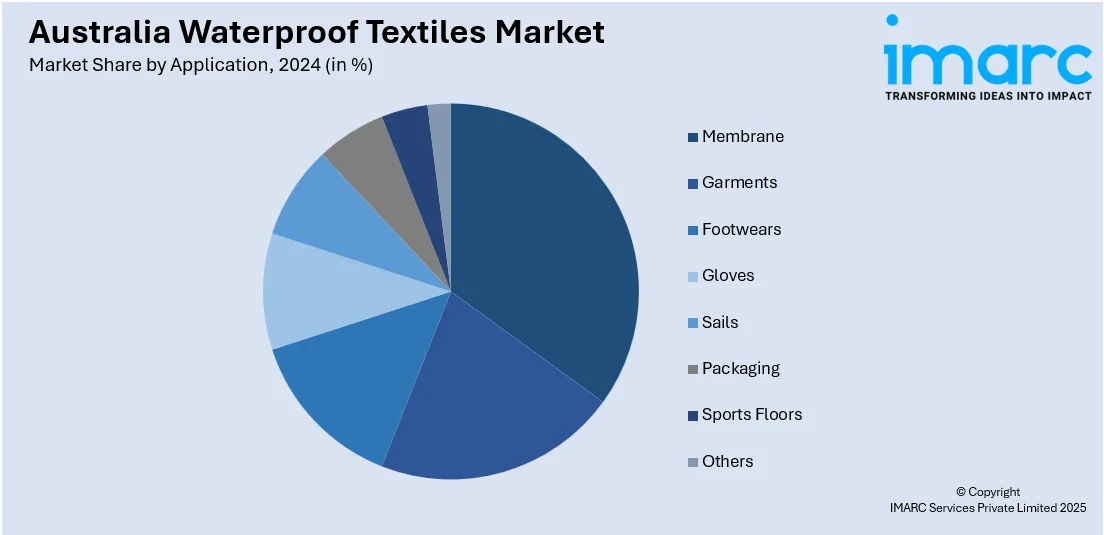
Australia Waterproof Textiles Market Size, Share, Trends and Forecast by Raw Material, Fabric Type, Application, and Region, 2025-2033
Australia Waterproof Textiles Market Overview:
The Australia waterproof textiles market size reached USD 54.19 Million in 2024. Looking forward, IMARC Group expects the market to reach USD 91.40 Million by 2033, exhibiting a growth rate (CAGR) of 5.98% during 2025-2033. The market is fueled by technological advancements in material, rising demand from outdoor and adventure sports, and sustainability. Developments in breathable membranes, sustainable materials, and water-based coatings are improving product performance while minimizing environmental footprint. With outdoor activities becoming highly popular, and consumers opting for sustainable choices, the market keeps growing. This trend is likely to substantially boost the Australia waterproof textiles market share in the future
|
Report Attribute
|
Key Statistics
|
|---|---|
|
Base Year
|
2024 |
|
Forecast Years
|
2025-2033
|
|
Historical Years
|
2019-2024
|
| Market Size in 2024 | USD 54.19 Million |
| Market Forecast in 2033 | USD 91.40 Million |
| Market Growth Rate 2025-2033 | 5.98% |
Australia Waterproof Textiles Market Trends:
Advancements in Material Technology
In Australia, the waterproof textile market is growing robustly, driven by ongoing improvements in material technology. New materials, such as breathable membranes and high-performance coatings have transformed the industry by offering better water resistance combined with comfort. With advancements in nanotechnology, fabrics are becoming more effective in that they can now repel water without compromising on breathability. Such advancements are highly pursued across industries like outerwear, wherein buyers call for both safety against weather and convenience in terms of movement. There are also ecofriendly awareness-inspired breakthroughs that aim at harnessing sustainable coating techniques and recoverable fibers towards delivering cleaner products. For instance, in September 2023, Deakin University and Xefco collaborated to create Ausora, a water-free method of dyeing fabrics, using plasma coating to drive sustainability and efficiency in the textiles sector, such as waterproof clothing. Furthermore, with mounting consumers being awakened to the superiority offered by advanced fabric technology, Australia's need for waterproof products is continually escalating at high rates. The convergence of function and sustainability puts Australia's market for waterproof fabrics on a course for further growth, providing customers with strong, state-of-the-art solutions across a range of uses.

To get more information on this market, Request Sample
Increase in Outdoor and Adventure Sports
Strong outdoor and adventure sports industry is a prime growth driver for Australia waterproof textiles market growth. The growing popularity of outdoor pursuits such as hiking, camping, surfing, and skiing has amplified demand for specialized outerwear and equipment that can endure the unforgiving Australian weather. Waterproof fabrics are now demanded not only to be hard-wearing and weather-resistant but also light and comfortable for extended wear. Producers are acting accordingly by making advanced materials based on specific athletic requirements, such as water-proof tops that absorb moisture and bottoms designed to sustain wet as well as dry climates. Increased development of water-proof material in Australia directly corresponds with the transition to consumer preference in favor of functional, high-performance products. As participation in outdoor sports continues to boost, demand for high-tech waterproof fabrics will continue to grow, underpinning the growth of the sector and responding to changing demands of active Australians.
Sustainability and Eco-Friendly Solutions
Sustainability is a growing trend in Australia's waterproof textiles industry. As people become more concerned about the environment, Australian consumers are becoming more aware of the environmental footprint of the products they purchase. Consequently, the waterproof textiles industry is moving towards more sustainable processes by employing environmentally friendly materials, like recycled polyester and natural fibers, to produce water-resistant fabrics. For instance, in December 2023, Rivertex launched Rivercyclon® 605 SD, a waterproof, 100% recyclable fabric that boasts outstanding UV resistance. It is designed for outdoor use and employs solution dyeing, making it sustainable and eco-friendly. Moreover, technologies, such as water-based finishes and biodegradable coatings are gaining popularity, enabling manufacturers to limit the use of harmful chemicals in textile manufacturing. The demand for waterproof textiles is not only performance-led in Australia but also fueled by the desire for products in sync with the environment. With mounting pressure for sustainability, Australian consumers are intensely choosing waterproof textiles that are durable, long-lasting, and eco-friendly. This transition towards eco-awareness is likely to continue influencing the market, creating long-term development while meeting the world's need for more environmentally friendly textile options.
Australia Waterproof Textiles Market Segmentation:
IMARC Group provides an analysis of the key trends in each segment of the market, along with forecasts at the country and regional levels for 2025-2033. Our report has categorized the market based on raw material, fabric type, and application.
Raw Material Insights:
- Polyurethane
- Expanded Polytetrafluoroethylene (ePTFE)
- Polyester
- Polyether
- Fluoropolymer
- Nylon
- Others
The report has provided a detailed breakup and analysis of the market based on the raw material. This includes polyurethane, expanded polytetrafluoroethylene (ePTFE), polyester, polyether, fluoropolymer, nylon, and others.
Fabric Type Insights:
- Dense Woven
- Laminated or Coated Woven
- Others
A detailed breakup and analysis of the market based on the fabric type have also been provided in the report. This includes dense woven, laminated or coated woven, and others.
Application Insights:

- Membrane
- Garments
- Jackets
- Waterproof Jackets
- Leisurewear
- Others
- Footwears
- Gloves
- Sails
- Packaging
- Sports Floors
- Others
The report has provided a detailed breakup and analysis of the market based on the application. This includes membrane, garments (jackets, waterproof jackets, leisurewear, others), footwears, gloves, sails, packaging, sports floors, and others.
Regional Insights:
- Australia Capital Territory & New South Wales
- Victoria & Tasmania
- Queensland
- Northern Territory & Southern Australia
- Western Australia
The report has also provided a comprehensive analysis of all the major regional markets, which include Australia Capital Territory & New South Wales, Victoria & Tasmania, Queensland, Northern Territory & Southern Australia, and Western Australia.
Competitive Landscape:
The market research report has also provided a comprehensive analysis of the competitive landscape. Competitive analysis such as market structure, key player positioning, top winning strategies, competitive dashboard, and company evaluation quadrant has been covered in the report. Also, detailed profiles of all major companies have been provided.
Australia Waterproof Textiles Market News:
- In April 2024, Australian sailing clothing market leader Zhik introduced high-performance wetsuits constructed from sustainable Yulex® rubber, a major breakthrough in the Australia waterproof textiles industry. By removing neoprene and lowering CO2 emissions by 80%, this breakthrough is in line with the industry's increasing trend toward environmentally friendly, performance-oriented materials for water-resistant equipment.
Australia Waterproof Textiles Market Report Coverage:
| Report Features | Details |
|---|---|
| Base Year of the Analysis | 2024 |
| Historical Period | 2019-2024 |
| Forecast Period | 2025-2033 |
| Units | Million USD |
| Scope of the Report |
Exploration of Historical Trends and Market Outlook, Industry Catalysts and Challenges, Segment-Wise Historical and Future Market Assessment:
|
| Raw Materials Covered | Polyurethane, Expanded Polytetrafluoroethylene (ePTFE), Polyester, Polyether, Fluoropolymer, Nylon, Others |
| Fabric Types Covered | Dense Woven, Laminated or Coated Woven, Others |
| Applications Covered |
|
| Regions Covered | Australia Capital Territory & New South Wales, Victoria & Tasmania, Queensland, Northern Territory & Southern Australia, Western Australia |
| Customization Scope | 10% Free Customization |
| Post-Sale Analyst Support | 10-12 Weeks |
| Delivery Format | PDF and Excel through Email (We can also provide the editable version of the report in PPT/Word format on special request) |
Key Questions Answered in This Report:
- How has the Australia waterproof textiles market performed so far and how will it perform in the coming years?
- What is the breakup of the Australia waterproof textiles market on the basis of raw material?
- What is the breakup of the Australia waterproof textiles market on the basis of fabric type?
- What is the breakup of the Australia waterproof textiles market on the basis of application?
- What is the breakup of the Australia waterproof textiles market on the basis of region?
- What are the various stages in the value chain of the Australia waterproof textiles market?
- What are the key driving factors and challenges in the Australia waterproof textiles?
- What is the structure of the Australia waterproof textiles market and who are the key players?
- What is the degree of competition in the Australia waterproof textiles market?
Key Benefits for Stakeholders:
- IMARC’s industry report offers a comprehensive quantitative analysis of various market segments, historical and current market trends, market forecasts, and dynamics of the Australia waterproof textiles market from 2019-2033.
- The research report provides the latest information on the market drivers, challenges, and opportunities in the Australia waterproof textiles market.
- Porter's five forces analysis assist stakeholders in assessing the impact of new entrants, competitive rivalry, supplier power, buyer power, and the threat of substitution. It helps stakeholders to analyze the level of competition within the Australia waterproof textiles industry and its attractiveness.
- Competitive landscape allows stakeholders to understand their competitive environment and provides an insight into the current positions of key players in the market.
Need more help?
- Speak to our experienced analysts for insights on the current market scenarios.
- Include additional segments and countries to customize the report as per your requirement.
- Gain an unparalleled competitive advantage in your domain by understanding how to utilize the report and positively impacting your operations and revenue.
- For further assistance, please connect with our analysts.
 Request Customization
Request Customization
 Speak to an Analyst
Speak to an Analyst
 Request Brochure
Request Brochure
 Inquire Before Buying
Inquire Before Buying




.webp)




.webp)












